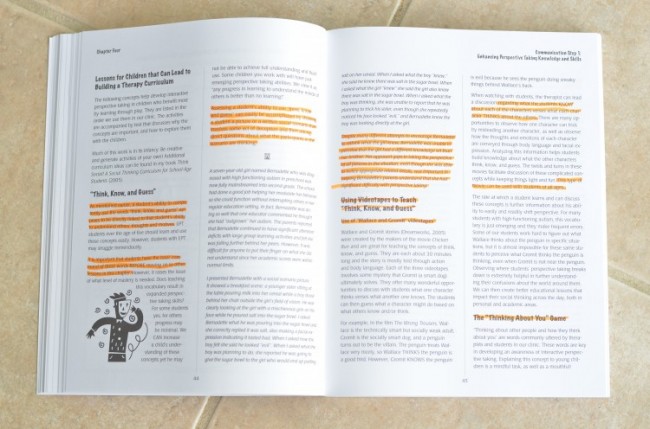I am so thrilled to be part of the Social Thinking Blogging team. As part of the team, I’ll be bringing you reviews of Social Thinking products, curriculums, books and conferences. If you are not familiar with Social Thinking, don’t worry. In each post I’ll give a quick explanation with links for more information. I have been using the Social Thinking Framework in practice with children aged 3 through middle school for about 7 years now. If you work with children with social-cognitive disabilities (or have a child who struggles with social skills and understanding social rules), I HIGHLY recommend the Social Thinking Framework. Disclosure: I was provided the items in this review at no cost in exchange for an honest review. As always, all thoughts and opinions are mine. There are affiliate links to Amazon in this post for your convenience.Â
What is Social Thinking®?
Social Thinking is a teaching framework for individuals aged preschool through adult, created by Michelle Garcia Winner, CCC-SLP (I’ll refer to her as  MGW) (www.socialthinking.com ). It consists of a Social Thinking Vocabulary that establishes a common language to discuss social functioning, curriculum lessons and strategies that break down social concepts into concrete, teachable formats, and the Social Thinking-Social Communication Profile, a tiered informal assessment tool that helps educators and clinicians better understand different levels of social cognition and match teaching strategies to the social strengths and challenges of the individual. Social Thinking “explodes the social code†to help children and adults learn to be better social thinkers and social communicators.
You can read about the Core Facts & Theories of Social Thinking Here.

What is Thinking About You, Thinking About Me?
Thinking About You, Thinking About Me is over 270 pages of extensive information, therapeutic activities, concrete strategies, complete lessons, sample IEP goals and more all about social-cognitive thinking. Specifically, this book targets the  perspective taking skills that are critical to a person’s ability to navigate the social world around them.
Who Is This Book For?
Thinking About You, Thinking About Me is for those professionals who work with children with social cognitive delays who have impairments in the ability to understand the perspectives of other people (think theory of mind). Speech-language pathologists, psychologists, occupational therapists, TEACHERS, etc. This book also is a wonderful resource for the parent of these children as well.
Who Has Social-Cognive Difficulties?
The ideas and strategies in this book are designed for children with:
- High Functioning Autism
- Asperger’s Syndrome
- Nonverbal Learning Disorder
- Attention Deficit Hyperactivity Disorder (ADHD)
- Hyperlexia
- Other children who may not have any “official diagnosis” but still struggle with the social world around them. Some of these children will have other speech-language delays while others will not. Sometimes we may call these “quirky” or “those kids we can’t quite place our finger on.”
You can read more HERE.
What Will I Learn From This Book?
In two words?
A LOT.
Ha, But really..Thinking About You, Thinking About Me is FULL of so much information, that it will take you a while to really get through it. Much of it was review for me, as I own the first edition of this book, (but there is a LOT more to this edition..I recommend upgrading if you only have the first edition) yet I chose to read it slowly, highlight, and take notes.

Let’s take a little tour of the book, to give you an idea of what you will learn:
- Introduction: MGW provides an introduction to the idea of social-cognitive deficits and cognitive theories that contribute to the therapeutic application of this book. She also reviews the I LAUGH Framework Model from her book Inside Out: What Makes the Person with Social Cognitive Deficits Tick (2000). You can read more about this model HERE.Â
- Perspective Taking: Thinking, learning and Teaching: MGW goes over a ton of information about perpective taking and theory of mind. She also goes over the different categories of perspective taking impairment.
- The Keys to Perspective Taking: All the deets on perspective taking. LOVE the Tables in this chapter that help you understand the different levels of understanding of perspective taking.
- The Four Steps to Communication:  MGW explains the framework for understanding Social thinking by breaking up communication into four steps. You can learn about the Four Steps to Communication Here. The book has four additional chapters that break down each of the Four Steps to Communication down and provides lessons, handouts, and activities to target these skills.
- Social Behavior Mapping: MGW developed social behavior mapping to help people with social-cognitive differences understand the relationship between their behaviors and the thoughts, feelings, perspectives and behaviors of the people around them. She explains behaviors as “expected” and “unexpected” and provides lessons, handouts and tips for using Social Behavior Mapping with clients/students.
- The ME Binder: Teaching Students About Their IEPs: Older children with social cognitive differnces will soon start to  realize and wonder why their school day is different from that of their peers. Why does he have to go to speech? Why does he have to go to the resource room? Why does he have different teachers from his friends? MGW proposes the use of the ME Binder..a binder for the older child that covers all information relating to his IEP and the professionals he works with. This includes MANY hand outs and tips on how to use the Me Binder in the school setting.
- About the Social Thinking Dynamic Assessment Protocol: Assessing  social-cognitive abilities is not an easy task, and so often, children and young adults who are very high functioning can actually perform quite well on standardized assessments, yet have significant impairments in social skills. MGW created the Social Thinking Dynamic Assessment protocol and explains this assessment in depth in this chapter. Included is a sample assessment report so you can see an example of how to present the information gathered.
- Standardized Assessments- Comments and Critiques: As I already mentioned, standardized assessments designed to measure social/pragmatic language skills are not always very accurate in really presenting how a child or young adult uses these skills in the *real world.* This chapter goes over the different assessments on the market and the pros and cons of each.
- The Social Thinking Dynamic Assessment Protocol: This is a full copy of the protocol explained in chapter 10.
What I Love About This Book
- History and Theories: MGW really delves into the theories behind theory of mind and perceptive taking, providing the reader with a strong base of knowledge to move forward on helping those children with social-cognitive challenges. Understanding the theories and studies on this subject are SO IMPORTANT for the ability to TREAT these deficits.
- The Language/Terms: So often, I will know what I know in my head, but have a hard time coming up with the best terms to use to explain to others what I am thinking. One of the things I love about Hanen is the wonderful terminology they use to help parents understand speech and language development and then how to help their child. MGW’s work is similar to this. She provides many different terms that can be used to help children (and their parents too!) understand theory of mind and perspective taking and the whole concept that “you are thinking about me and I am thinking about you” and therefore I will adjust my actions based on those thoughts. For most of us, these skills come naturally. So natural, in fact, that it can be so hard to explain to others how we do it! That is what MGW does in her books.
- Examples from the Clinic: One of my favorite parts of this book, are the real-life examples MGW provides within the chapters. She shares experiences from her clinic to help you gain more insight into how difficult perspective taking can be for these children and how she has used her methods in the clinic to help her client’s understand how and why we
- Lessons and Activities: This is MORE than just a book…it provides assessment and curriculum for treating children and young adults with social cognitive challenges. She provides hand outs, lessons, activities, discussion ideas, and examples of how she has used them in her clinic.
- Sample IEP goals: Wondering how on EARTH to write goals for social-cognitive goals? MGW provides sample goals for you.
Where Can I Buy This Book?
You can purchase Thinking About You, Thinking About Me at Amazon
. You can also purchase it directly from the Social Thinking Website.
What do you Think? Do YOU Use the Social Thinking Curriculum in YOUR Practice?
So now that you have read MY review and thoughts, I want to hear from YOU. Do you use the Social Thinking Curriculum in YOUR practice? Why or why not? I am really excited to be heading off to the 6th Annual Social Thinking Providers Conference tomorrow to learn more about how others use these products and curriculum in practice.
Thanks for sharing your book review, Katie! I’m always looking for new books to read (both personal and professional), so I will add this to the list. I teach preschool, so I know this will be a great resource. Thanks again.
Mary Catherine recently posted..End of Year Portfolios {with Poem}
I’ve been to like 10 of her conferences and have her books and make my social skills units based on her thoughts! Wish I could attend her longer (week long) trainings!!
CC recently posted..Sentence Frames (with freebie!)
I just got this and am so excited about it! I am glad that you are blogging about it, so I can hear your thoughts about it too 🙂
Jenn
Crazy Speech World
Jenn Alcorn recently posted..Summer Picnic Freebie!